Replica
A replica of the Columbia, built by the Eastern Shipbuilding Group, was launched in Panama City, Florida in 2014 and has taken part in the America's Cup Superyacht Regatta. [3]

Columbia was an American schooner, a fishing vessel launched in 1923. She took part in several races, and subsequently disappeared off Nova Scotia in 1927. A replica was built in 2014.
The original Columbia was a gaff rigged topsail schooner of 140 tons, built in Essex, Massachusetts and launched on April 7, 1923. She was designed by W. Starling Burgess and built by Arthur Dana Story. [1] She was built to race the Canadian schooner Bluenose .
The International Fisherman's Trophy was awarded to the fastest fishing schooner that worked in the North Atlantic deep sea fishing industry. The fastest schooner had to win two out of three races in order to claim the trophy.
At the hands of her skipper, Ben Pine, Columbia came very close to reclaiming the Esperanto Cup (the trophy from the International Fishermen's Races) [2] for the US in 1923, but no winner was named. [3] [4]
The International Fishermen's Trophy race was held off Halifax, Nova Scotia in October 1923 and new rules were put in place preventing ships from passing marker buoys to landward. During the first race, the schooners dueled inshore, the rigging of the vessels coming together. However, Bluenose won the first race. During the second race, Bluenose broke the new rule and was declared to have lost the race. Captain Angus Walters protested the decision and demanded that no vessel be declared winner. The judging committee rejected his protest, which led Walters to remove Bluenose from the competition. [5] The committee declared the competition a tie, and the two vessels shared the prize money and the title. The anger over the events led to an eight-year hiatus in the race.
She won her trials in 1926, but never again took part in the finals. [3]
On August 26, 1927, while fishing, Columbia and her crew of 22 disappeared off Sable Island. [3] [4]
A replica of the Columbia, built by the Eastern Shipbuilding Group, was launched in Panama City, Florida in 2014 and has taken part in the America's Cup Superyacht Regatta. [3]


A schooner is a type of sailing vessel defined by its rig: fore-and-aft rigged on all of two or more masts and, in the case of a two-masted schooner, the foremast generally being shorter than the mainmast. A common variant, the topsail schooner also has a square topsail on the foremast, to which may be added a topgallant. Differing definitions leave uncertain whether the addition of a fore course would make such a vessel a brigantine. Many schooners are gaff-rigged, but other examples include Bermuda rig and the staysail schooner.
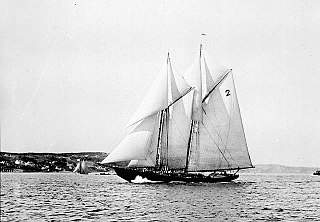
Bluenose was a fishing and racing gaff rig schooner built in 1921 in Lunenburg, Nova Scotia, Canada. A celebrated racing ship and fishing vessel, Bluenose under the command of Angus Walters, became a provincial icon for Nova Scotia and an important Canadian symbol in the 1930s, serving as a working vessel until she was wrecked in 1946. Nicknamed the "Queen of the North Atlantic", she was later commemorated by the Bluenose one-design sloop (1946) and a replica, Bluenose II (1963). The name Bluenose originated as a nickname for Nova Scotians from as early as the late 18th century.
The Banks dory, or Grand Banks dory, is a type of dory. They were used as traditional fishing boats from the 1850s on the Grand Banks of Newfoundland. The Banks dory is a small, open, narrow, flat-bottomed and slab-sided boat with a particularly narrow transom. They were inexpensive to build and could be stacked or nested inside each other and stored on the decks of larger fishing vessels which functioned as mother ships.

Riverport is a village in Lunenburg County, Nova Scotia, Canada. The harbour of Ritcey Cove is free from shoals and safe from every wind, considered one of the finest in North America. Riverport is a five-minute drive to several public beaches including Hirtle's Beach, Kingsburg Beach, Oxner Beach, Rose Bay Beach and Spindler Beach.

Bluenose II is a replica of the fishing and racing schooner Bluenose, commissioned by Sidney Culverwell Oland and built in 1963 as a promotional yacht for Oland Brewery. Sidney Oland donated the schooner to Nova Scotia in 1971 and it has since operated as a sailing ambassador and promotional device for Nova Scotia tourism. In honour of her predecessor's record, Bluenose II does not officially race.
William James Roué was a naval architect famous for his design of the fishing schooner Bluenose, which sailed to victory in the Halifax Herald International Fisherman's competition in 1921, 1922, 1923, 1931 and 1938, and held the record for the largest catch of fish ever brought into Lunenburg, Nova Scotia.
Bluenose or Blue nose may refer to:
The Delawana was a fishing schooner based in Riverport, Nova Scotia.
Esperanto was a fishing schooner based in Gloucester, Massachusetts.
Martin Leander Welch (1864–1935) was a fishing schooner captain out of Gloucester, Massachusetts. He was captain of the Esperanto in 1920 when it defeated the Canadian schooner Delawana in the first International Fishing Schooner Championship Races in Halifax, Nova Scotia.
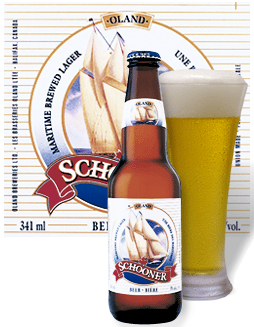
Schooner is a regional lager style beer of the eastern Canadian provinces. It has an alcohol content of 5.0% ABV and is brewed at the Oland Brewery in Halifax, Nova Scotia.

Gertrude L. Thebaud was an American fishing and racing schooner built and launched in Essex, Massachusetts in 1930. A celebrated racing competitor of the Canadian Bluenose, it was designed by Frank Paine and built by Arthur D. Story for Louis A. Thebaud, and named for his wife, Gertrude Thebaud. In their first meeting at Gloucester, Massachusetts in October 1930, Gertrude L. Thebaud bested Bluenose 2-0 to win the Sir Thomas Lipton International Fishing Challenge Cup. However, in 1931, two races to none, and again in 1938, three races to two, Bluenose defeated Gertrude L. Thebaud to remain the undefeated holder of the International Fisherman's Trophy. During World War II, the schooner saw service with the United States Coast Guard. The vessel sank in 1948 off the coast of Venezuela.

Angus James Walters was a sailor and sea captain who skippered the famed Grand Banks fishing schooner Bluenose from 1921 to 1938. Walters captained Bluenose to five international sailing championships, and was undefeated for seventeen years.

Sherman Zwicker is a wooden auxiliary fishing schooner built in 1942 at the Smith and Rhuland shipyard, Lunenburg, Nova Scotia. Influenced by the design of the famous Bluenose, Sherman Zwicker was built to fish the Grand Banks. The schooner was built for F. Homer Zwicker of Zwicker and Co. Officially christened in 1942, the F/V Sherman Zwicker is the last operable saltbank fishing vessel in existence.
James Havelock Harding, was a master shipwright and shipbuilder who worked at Shelburne, Nova Scotia. He was born in Queens County, Nova Scotia, Canada in 1883.
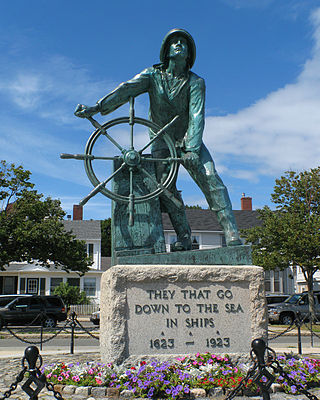
Richard Moses Murphy (1838–1916) was a well-known schooner captain who sailed out of Gloucester, Massachusetts, during the late 19th-century. Some of his experiences as a mariner are detailed in a chapter titled "The Adventures of Captain Richard Murphy" in The Fisherman’s Own Book, published by Proctor Brothers in 1882.
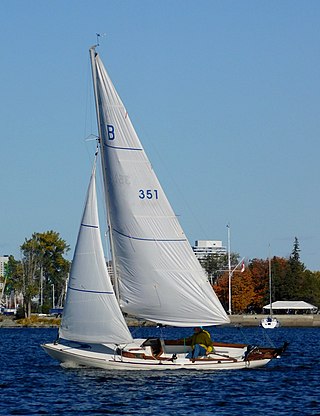
The Bluenose is a Canadian sailboat, that was designed by William James Roué as a one design racer and first built in 1946. Roué was also the designer of the Bluenose racing schooner, built in 1921. The term Bluenoser is a nickname for people from Nova Scotia.
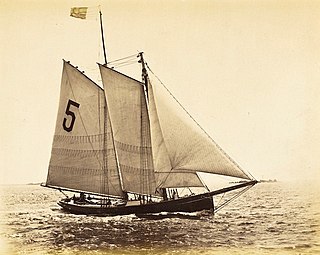
The Hesper was a 19th-century Boston pilot boat built in 1884, designed from a model by Dennison J. Lawlor as a Boston yacht and pilot-boat for merchant and ship owner George W. Lawler. She was known to be the largest pilot boat under the American flag at 104 feet long and the fastest of the Boston fleet. She competed in several first-class sailing races, and in 1886, the Hesper won the silver cup in what was known as the first Fishermen's Race. She was withdrawn from the pilot service and sold in 1901. The Hesper became a wreck on the point off Cape Henlopen in 1919.

Thomas Francis McManus was a fish merchant who became a naval architect, who introduced a shortened bowsprit and long stern overhang to make his vessels faster. He was well known for revolutionizing the Gloucester fishing schooner. He made the fastest vessels of their type in the world, and was honored on two continents for his skill as a naval architect. He became known as the "Father of the Fishermen's Races." 500 fishing schooners used his designs to improve speed. He was a friend of Sir Thomas Lipton and President Theodore Roosevelt.

Moses Adams, was an Essex County shipbuilder. He had his own shipyard and built eighty-five schooners and pilot boats. Adams died in Essex, Massachusetts in 1894.